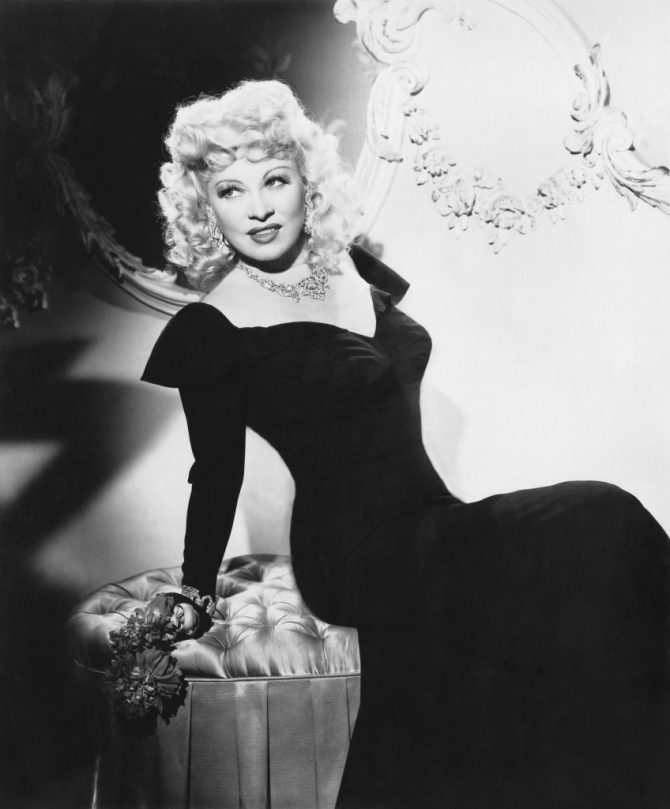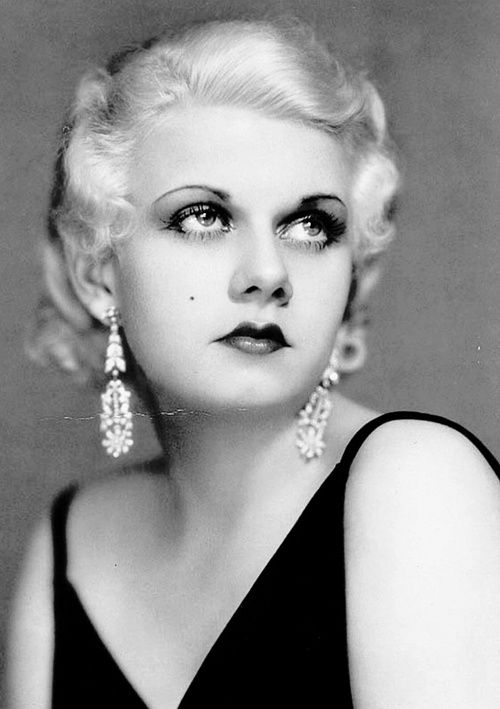Mae West. Jean Harlow. Marilyn Monroe.
These three actresses are part of the iconic women in Hollywood’s history known as the blonde bombshells. The blonde bombshell craze began when Jean Harlow - the original blonde bombshell - appeared in the appropriately titled film Platinum Blonde, opens a new window (1931). After the film, peroxide flew off the shelves so women could mimic Harlow’s blonde tresses.
Blonde hair was not the only requirement for the blonde bombshell. The blonde bombshell, whether playing the "femme fatale" (such as Barbara Stanwyck as Phyllis Dietrichson in Double Indemnity, opens a new window), the "girl next door" (such as Betty Grable as Loco Dempsey in How to Marry a Millionaire, opens a new window), or the "dumb blonde" (such as Marilyn Monroe as Lorelei Lee in Gentlemen Prefer Blondes, opens a new window), was beautiful and sensual (and at times very risqué). These women were adored by men and emulated by women.
Mae West
 West was born in 1893 in Brooklyn, New York. After a career working in vaudeville and Broadway shows, she started her film career when she moved to Hollywood in 1932. Her first film, Night After Night, opens a new window (1932) was followed by seven other films during the 1930s, including She Done Him Wrong, opens a new window (1933), I'm No Angel, opens a new window (1933), Belle of the Nineties, opens a new window (1934), and Klondike Annie, opens a new window (1936), the last three films she wrote and starred in. West would star in only four more films, but her blonde hair, hourglass figure, and incredible one-liners, such as “It's not the men in my life that count - it's the life in my men” from I'm No Angel, opens a new window (1933) and “Why don't you come up some time and see me?” from She Done Him Wrong, opens a new window (1933). Mae only made 12 movies, but these were enough to seal her fame and launch the legend.
West was born in 1893 in Brooklyn, New York. After a career working in vaudeville and Broadway shows, she started her film career when she moved to Hollywood in 1932. Her first film, Night After Night, opens a new window (1932) was followed by seven other films during the 1930s, including She Done Him Wrong, opens a new window (1933), I'm No Angel, opens a new window (1933), Belle of the Nineties, opens a new window (1934), and Klondike Annie, opens a new window (1936), the last three films she wrote and starred in. West would star in only four more films, but her blonde hair, hourglass figure, and incredible one-liners, such as “It's not the men in my life that count - it's the life in my men” from I'm No Angel, opens a new window (1933) and “Why don't you come up some time and see me?” from She Done Him Wrong, opens a new window (1933). Mae only made 12 movies, but these were enough to seal her fame and launch the legend.
Mae West: The Glamour Collection, opens a new window includes the films Night After Night, opens a new window (1932), I'm No Angel, opens a new window (1933), Goin' to Town, opens a new window (1935), Go West Young Man, opens a new window (1936), and My Little Chickadee, opens a new window (1940).
Becoming Mae West, opens a new window by Emily Wortis Leider
Mae West (1893-1980)--the offspring of a classic stage mother and boxer father--evolved from vaudeville performer to the popular--but not critically acclaimed--liberated stage and movie actress of My Little Chickadee (1940) fame. Always trying to stay one step ahead of the censors and losing out temporarily to the Hayes Office in 1930 when it put Diamond Lil (also known as She Done Him Wrong) on the banned list, West represented adventuresomeness in sexuality and career savvy by a female entertainer.
Mae West: It Ain't No Sin, opens a new window by Simon Louvish
Sex goddess, Hollywood star, transgressive playwright, author, blues singer, and vaudeville brat - Mae West remains a unique 20th-century figure. She made an everlasting mark in trailblazing Broadway plays and films. Biographer Louvish charts her amazing seven decades in show business, from early years in teenage summer stock to her last reincarnation as 1960s gay icon and grande dame of Hollywood survivors.
Jean Harlow
 The original blonde bombshell was born Harlean Carpenter on March 3, 1911, in Kansas City, Missouri. Harlow made her first big splash in the Laurel and Hardy classic Double Whoopee, opens a new window (1929), but it was her performance in The Saturday Night Kid, opens a new window (1929) that would catch film producer’s Howard Hughes attention and catapult her into stardom. Harlow starred in Hughes’ film Hells Angels, opens a new window (1930), which created a sensation with her line “Would you be shocked if I put on something more comfortable?” Harlow appeared in 41 films before her untimely death from uremic poisoning on June 7, 1937, at the age of 26.
The original blonde bombshell was born Harlean Carpenter on March 3, 1911, in Kansas City, Missouri. Harlow made her first big splash in the Laurel and Hardy classic Double Whoopee, opens a new window (1929), but it was her performance in The Saturday Night Kid, opens a new window (1929) that would catch film producer’s Howard Hughes attention and catapult her into stardom. Harlow starred in Hughes’ film Hells Angels, opens a new window (1930), which created a sensation with her line “Would you be shocked if I put on something more comfortable?” Harlow appeared in 41 films before her untimely death from uremic poisoning on June 7, 1937, at the age of 26.
Platinum Girl: The Life and Legends of Jean Harlow, opens a new window by Eve Golden
The movie star whose hair inspired the phrase "platinum blonde,'' Jean Harlow had a sexy, comic reputation on screen but was, as Golden emphasizes, more comfortable in casual clothes, relaxing with family and friends. Harlow packed a lot of living into a short time: after her career took off in 1930 with the release of Hell's Angels, she was Hollywood's blonde bombshell (the title of one of her movies) until her sudden death of kidney failure in 1937 at age 26.
Dinner at Eight, opens a new window
A Park Avenue snob gives a dinner party for a visiting English peer. Little does she realize that her shipping magnate husband is bankrupt and that her daughter is having an affair with an older man.
Public Enemy, opens a new window
Two slum boys start out as bootleggers and climb to be big-time gangsters.
Marilyn Monroe
 Marilyn Monroe was born Norma Jean Mortenson on June 1, 1926, in Los Angeles, California. Monroe’s acting career began with minor roles and uncredited parts under contract to Twentieth Century Fox. When her contract ended, Monroe did some modeling until she appeared as a minor character in All About Eve, opens a new window (1950), which won her recognition and another contract with Fox. Throughout the early to mid-50s, Monroe’s star power rose with films like Gentlemen Prefer Blondes, opens a new window (1953), How to Marry a Millionaire, opens a new window (1953), and There's No Business Like Show Business, opens a new window (1954). Monroe’s only critical success came from her portrayal of a ukulele-playing singer in Some Like It Hot, opens a new window (1959). In total, Monroe appeared in 33 films before her early death at the age of 36 from an overdose.
Marilyn Monroe was born Norma Jean Mortenson on June 1, 1926, in Los Angeles, California. Monroe’s acting career began with minor roles and uncredited parts under contract to Twentieth Century Fox. When her contract ended, Monroe did some modeling until she appeared as a minor character in All About Eve, opens a new window (1950), which won her recognition and another contract with Fox. Throughout the early to mid-50s, Monroe’s star power rose with films like Gentlemen Prefer Blondes, opens a new window (1953), How to Marry a Millionaire, opens a new window (1953), and There's No Business Like Show Business, opens a new window (1954). Monroe’s only critical success came from her portrayal of a ukulele-playing singer in Some Like It Hot, opens a new window (1959). In total, Monroe appeared in 33 films before her early death at the age of 36 from an overdose.
Marilyn Monroe: The Life of an Actress, opens a new window by Carl E. Rollyson
With over 30 black-and-white photographs (some published for the first time), a new foreword, and a new afterword, this volume brings Rollyson's 1986 book up to date. From this comprehensive yet critically measured wealth of material, Rollyson offers a distinctive and insightful portrait of Marilyn Monroe, highlighted by new perspectives that depict the central importance of acting to the authentic aspects of her being.
My Sister Marilyn: A Memoir of Marilyn Monroe, opens a new window by Berniece Baker Miracle
In My Sister Marilyn, Berniece Baker Miracle and Mona Rae Miracle share memories of their famous relative - a story they have kept private since the early days of Marilyn's fame. Their purpose is the opposite of sensationalism: they want Marilyn's fans to know the warm-hearted woman they knew - the one who sent them her favorite dresses, repeatedly warned them about protecting their privacy, and tried to provide her schizophrenic mother with a home even as her own world became increasingly troubled.
Joe and Marilyn: Legends in Love, opens a new window by C. David Heymann
Explores the passionate, sometimes volatile relationship between baseball great Joe DiMaggio and Hollywood icon Marilyn Monroe.

